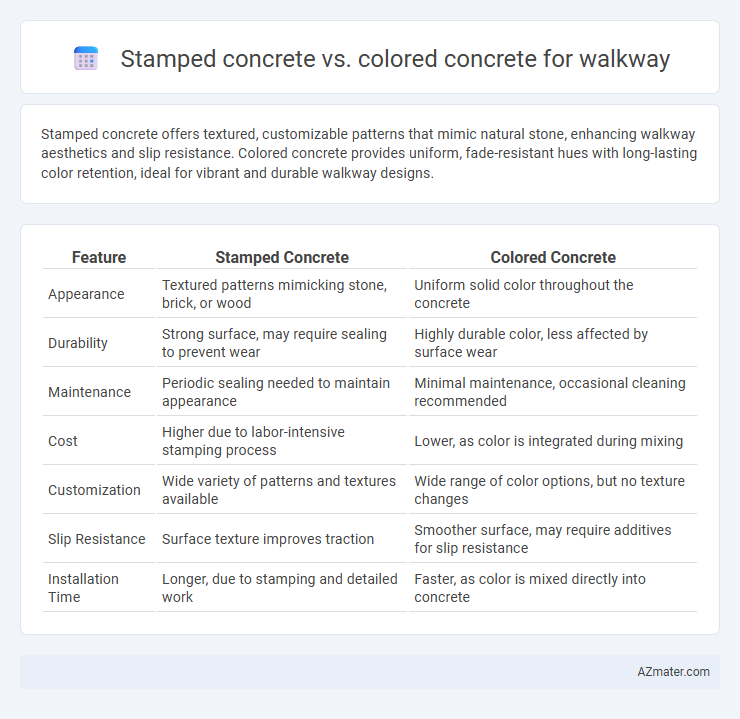Stamped concrete offers textured, customizable patterns that mimic natural stone, enhancing walkway aesthetics and slip resistance. Colored concrete provides uniform, fade-resistant hues with long-lasting color retention, ideal for vibrant and durable walkway designs.
Table of Comparison
| Feature | Stamped Concrete | Colored Concrete |
|---|---|---|
| Appearance | Textured patterns mimicking stone, brick, or wood | Uniform solid color throughout the concrete |
| Durability | Strong surface, may require sealing to prevent wear | Highly durable color, less affected by surface wear |
| Maintenance | Periodic sealing needed to maintain appearance | Minimal maintenance, occasional cleaning recommended |
| Cost | Higher due to labor-intensive stamping process | Lower, as color is integrated during mixing |
| Customization | Wide variety of patterns and textures available | Wide range of color options, but no texture changes |
| Slip Resistance | Surface texture improves traction | Smoother surface, may require additives for slip resistance |
| Installation Time | Longer, due to stamping and detailed work | Faster, as color is mixed directly into concrete |
Introduction to Stamped and Colored Concrete Walkways
Stamped concrete walkways replicate the appearance of natural materials such as stone, brick, or wood through textured patterns, offering durable and visually appealing surfaces that enhance outdoor paths. Colored concrete walkways involve integrating pigments directly into the mix, producing vibrant, long-lasting hues that resist fading and provide customizable design options. Both options combine functionality with aesthetic versatility, making them popular choices for enhancing residential and commercial walkways.
What Is Stamped Concrete?
Stamped concrete for walkways is a decorative surface created by imprinting patterns and textures onto freshly poured concrete to replicate materials such as brick, stone, or slate. This technique enhances durability while providing a visually appealing, slip-resistant surface ideal for outdoor paths. Stamped concrete offers customizable colors and patterns, making it a versatile choice compared to uniformly colored concrete.
What Is Colored Concrete?
Colored concrete for walkways incorporates integral pigments or surface-applied stains to achieve a consistent, durable hue throughout the material, enhancing aesthetic appeal and allowing customization to match surrounding landscapes. Unlike stamped concrete, which uses molds to create textured patterns mimicking natural stone or brick, colored concrete emphasizes uniform color without texture alteration, making it ideal for sleek, modern designs. Its blend of strength, versatility, and resistance to fading ensures long-lasting walkways with vibrant, consistent coloration.
Aesthetic Appeal: Patterns vs. Solid Colors
Stamped concrete offers a diverse range of intricate patterns that mimic natural materials like stone, brick, or wood, providing a textured and visually dynamic walkway surface. Colored concrete delivers uniform, solid hues that create a clean, contemporary look with consistent shading and vibrant color retention over time. Choosing between stamped and colored concrete hinges on whether the desired walkway aesthetic emphasizes detailed texture and pattern or sleek, solid color presentation.
Cost Comparison: Stamped vs. Colored Concrete
Stamped concrete typically costs between $8 to $18 per square foot due to the labor-intensive stamping process and customization options. Colored concrete, usually priced from $3 to $10 per square foot, is more affordable because it involves mixing pigments directly into the concrete without additional texturing steps. Cost variations depend on factors such as project size, complexity, and regional labor rates, making stamped concrete generally more expensive but ideal for decorative walkways requiring intricate patterns.
Installation Process and Time
Stamped concrete involves pressing molds into freshly poured concrete to create textured designs, requiring a skilled installation team to ensure patterns align and curing is carefully monitored, typically taking 2 to 3 days including curing time. Colored concrete incorporates integral pigments mixed into the concrete batch before pouring, simplifying the process since no special stamping or surface treatments are needed, generally allowing for faster installation and curing within 24 to 48 hours. Both options require proper surface preparation and finishing, but stamped concrete demands more labor-intensive steps, extending installation time compared to colored concrete for walkways.
Durability and Maintenance Requirements
Stamped concrete offers enhanced durability due to its thicker overlays and textured patterns, making it resistant to cracking and surface wear for walkways. Colored concrete integrates pigments throughout the mix, providing long-lasting color that resists fading but may be more prone to surface scratches and requires periodic sealing. Both options demand regular maintenance, with stamped concrete needing more frequent sealing to preserve texture and color, while colored concrete maintenance focuses on cleaning and resealing to prevent discoloration and surface degradation.
Slip Resistance and Safety Considerations
Stamped concrete offers enhanced slip resistance due to its textured surface, making it a safer option for walkways in wet or icy conditions. Colored concrete, while visually appealing with its uniform hue, typically has a smoother finish that may require additional slip-resistant treatments to meet safety standards. Both options can be customized with sealants or anti-slip additives to improve traction and reduce fall hazards in pedestrian areas.
Long-Term Value and Lifespan
Stamped concrete offers superior long-term value for walkways due to its durability and ability to mimic expensive materials like stone or brick, maintaining aesthetic appeal over decades. Colored concrete, while more affordable initially, may fade faster under UV exposure and weather, requiring more frequent maintenance and re-coloring to preserve its appearance. Choosing stamped concrete enhances lifespan and reduces repair costs, resulting in better overall return on investment for walkway installations.
Choosing the Right Concrete Option for Your Walkway
Stamped concrete offers intricate patterns and textures that mimic natural materials like stone or brick, enhancing the aesthetic appeal of walkways while providing slip resistance. Colored concrete allows for a consistent, vibrant hue throughout the pavement, ensuring long-lasting color retention with UV-stable pigments, ideal for design uniformity. Selecting the right option depends on desired visual impact, maintenance considerations, and budget, with stamped concrete favoring decorative complexity and colored concrete emphasizing steady, durable coloration.

Infographic: Stamped concrete vs Colored concrete for Walkway
 azmater.com
azmater.com